-
Countries
-
Data and Analysis
-
Special Focus
-
Crisis Responses

Contact
DTM Nigeria, iomnigeriadtm@iom.int
Language
English
Location
Nigeria
Snapshot Date
Jun 16 2023
Activity
- Registration
- Biometric Registration
As part of its commitment to provide lasting solutions for internally displaced persons (IDPs) who cannot return to their places of origin, the International Organization for Migration (IOM) has actively supported the resettlement of 188 displaced families in Malkohi New City located in Yola South Local Government Area (LGA) of Adamawa State. To achieve this, the IOM has facilitated the construction of 218 housing units.
To ensure the success of this resettlement project and to better understand the community's composition, the Displacement Tracking Matrix (DTM) conducted a biometric verification and registration exercise in Malkohi New City. The primary objectives of this exercise were to identify the residents of the city and to identify and profile the vulnerable individuals within the community.
As of 16 June 2023, the DTM has successfully registered 1,105 IDPs from 188 households in Malkohi New City. The data obtained from this exercise revealed that 17 per cent of the families consist of 1 - 2 members, 22 per cent comprise 3 - 4 members, 29 per cent comprise 5 - 6 members, 17 per cent comprise 7 - 8 members and 16 per cent comprise 9 or more members. The average family size in the location is six members.
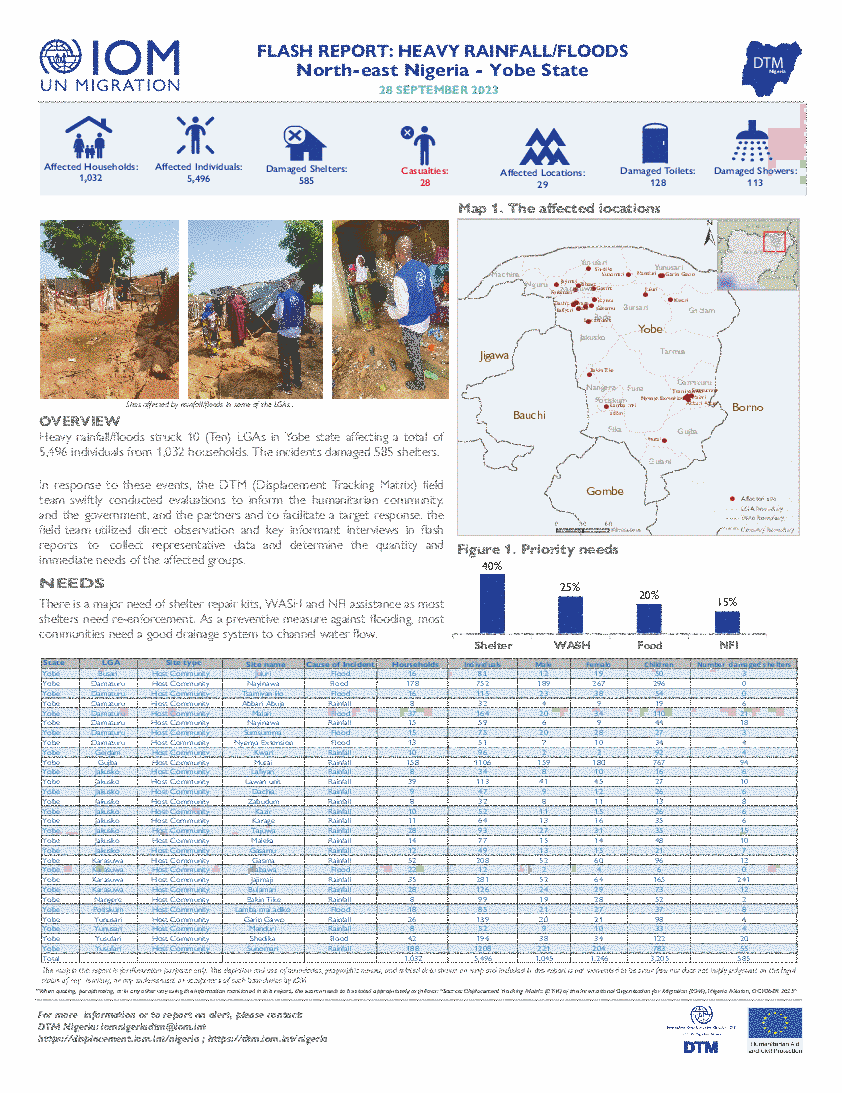
Contact
DTM Nigeria, iomnigeriadtm@iom.int
Language
English
Location
Nigeria
Snapshot Date
Sep 28 2023
Activity
- Mobility Tracking
- Event Tracking
Heavy rainfall/floods struck 10 (Ten) LGAs in Yobe state affecting a total of 5,496 individuals from 1,032 households. The incidents damaged 585 shelters.
In response to these events, the DTM (Displacement Tracking Matrix) field team swiftly conducted evaluations to inform the humanitarian community, and the government, and the partners and to facilitate a target response. the field team utilized direct observation and key informant interviews in flash reports to collect representative data and determine the quantity and immediate needs of the affected groups.
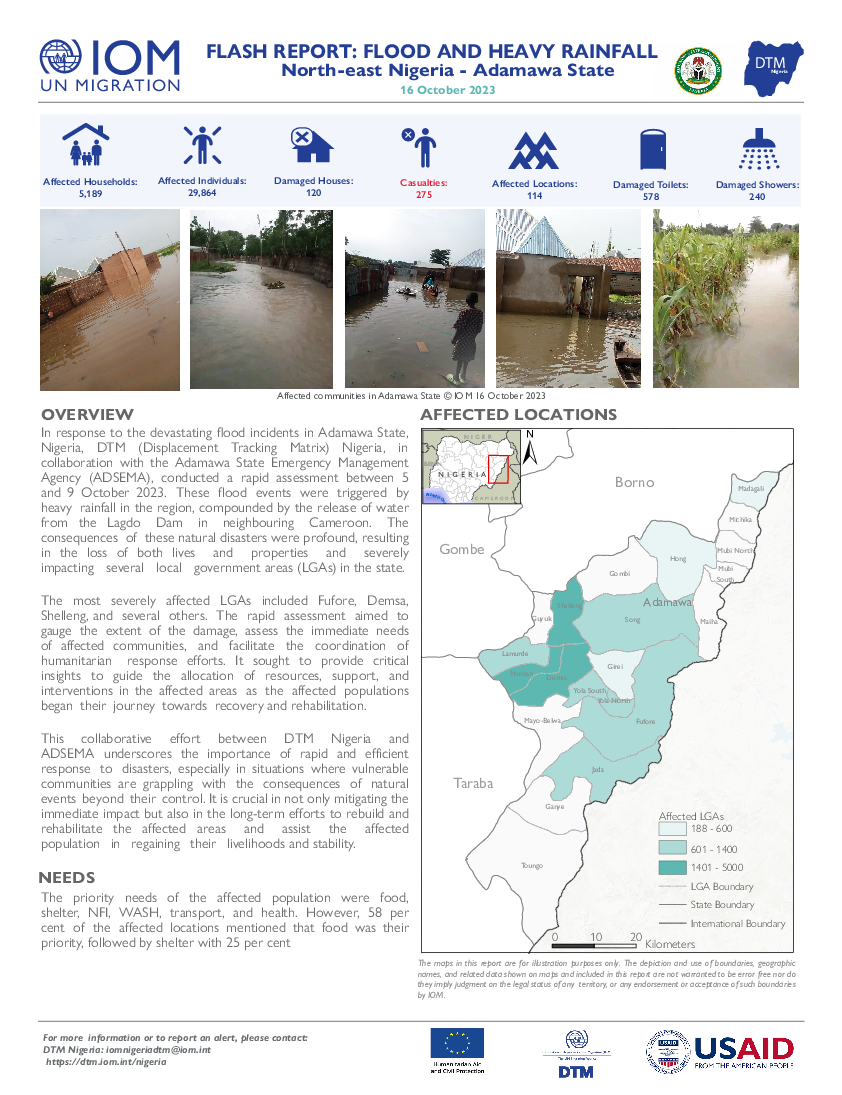
Contact
DTM Nigeria, iomnigeriadtm@iom.int
Language
English
Location
Nigeria
Period Covered
Oct 05 2023
Oct 09 2023
Activity
- Mobility Tracking
- Event Tracking
In response to the devastating flood incidents in Adamawa State, Nigeria, DTM (Displacement Tracking Matrix) Nigeria, in collaboration with the Adamawa State Emergency Management Agency (ADSEMA), conducted a rapid assessment between 5 and 9 October 2023. These flood events were triggered by heavy rainfall in the region, compounded by the release of water from the Lagdo Dam in neighbouring Cameroon. The consequences of these natural disasters were profound, resulting in the loss of both lives and properties and severely impacting several local government areas (LGAs) in the state.
The most severely affected LGAs included Fufore, Demsa, Shelleng, and several others. The rapid assessment aimed to gauge the extent of the damage, assess the immediate needs of affected communities and facilitate the coordination of humanitarian response efforts. It sought to provide critical insights to guide the allocation of resources, support, and interventions in the affected areas as the affected populations began their journey towards recovery and rehabilitation.
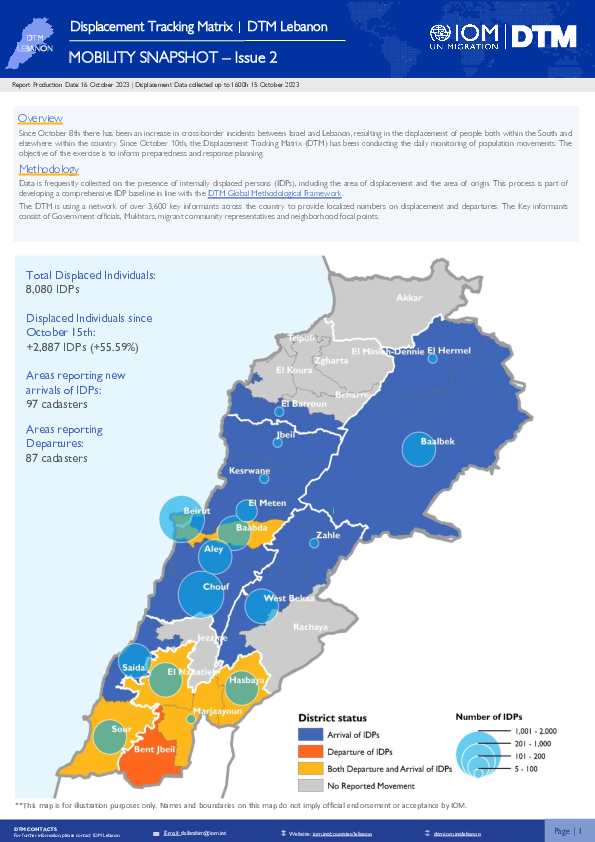
Contact
daibrahim@iom.int
Language
English
Location
Lebanon
Period Covered
Oct 10 2023
Oct 15 2023
Activity
- Mobility Tracking
- Baseline Assessment
Since October 8, there has been an increase in cross-border incidents between Israel and Lebanon, resulting in the displacement of people both within the South and elsewhere within the country. Since October 10, the Displacement Tracking Matrix (DTM) has been conducting the daily monitoring of population movements.
Contact
DTM Libya, DTMLibya@iom.int
Language
English
Location
Libya
Snapshot Date
Sep 30 2023
Activity
- Mobility Tracking
- Site Assessment
Detention Centre Profiling is a component of IOM Libya’s Displacement Matrix programme. It is a data oriented tool that routinely provides specific sex and age demographic data and key sectorial information on individuals held in Libya’s detention centres on the date of assessment.
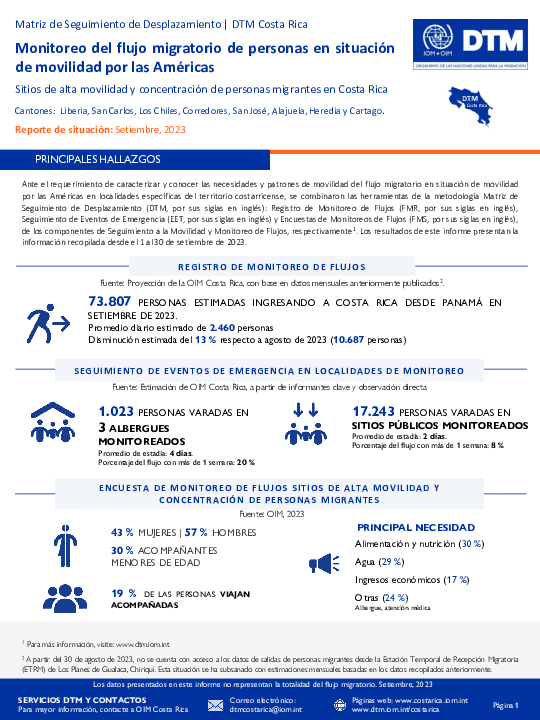
Contact
DTMCostaRica@iom.int
Language
Spanish
Location
Costa Rica
Period Covered
Sep 01 2023
Sep 30 2023
Activity
- Flow Monitoring
- Mobility Tracking
- Event Tracking
Cantones: Liberia, Los Chiles, San Carlos, Heredia, Alajuela, Cartago, San José y Corredores.
Costa Rica, al igual que los demás países de la región centroamericana, se ha caracterizado por ser un corredor migratorio para personas que transitan de manera terrestre desde el sur hasta el norte de América y que tienen como destino los países del norte del continente. Este flujo en situación de movilidad por las Américas se encuentra compuesto principalmente por personas de la República Bolivariana de Venezuela, Cuba, Haití, Ecuador, así como personas provenientes de otros países de Suramérica, África y Asia.
Según estimaciones de la OIM Costa Rica, durante setiembre ingresaron al país 73.087 personas, un promedio de 2460 personas por día y estimando una disminución de un 13% con respecto a agosto de 2023. Además, se identificaron 1.023 personas varadas en los albergues monitoreados y 17.243 personas varadas en los sitios públicos visitados.
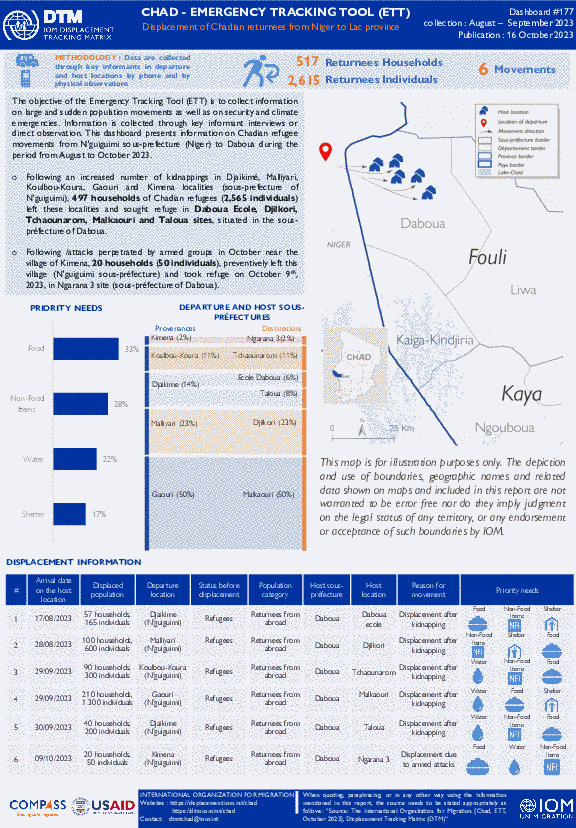
Contact
DTM Chad, dtmtchad@iom.int
Language
English
Location
Chad
Period Covered
Aug 01 2023
Oct 09 2023
Activity
- Mobility Tracking
- Event Tracking
The objective of the Emergency Tracking Tool (ETT) is to collect information on large and sudden population movements as well as on security and climate emergencies. Information is collected through key informant interviews or direct observation. This dashboard presents information on Chadian refugee movements from N'guiguimi sous-prefecture (Niger) to Daboua during the period from August to October 2023.
- Following an increased number of kidnappings in Djaikimé, Malliyari, Koulbou-Koura, Gaouri and Kimena localities (sous-prefecture of N'guiguimi), 497 households of Chadian refugees (2,565 individuals) left these localities and sought refuge in Daboua Ecole, Djilkori, Tchaounarom, Malkaouri and Taloua sites, situated in the sous-préfecture of Daboua.
- Following /attacks perpetrated by armed groups in October near the village of Kimena, 20 households (50 individuals), preventively left this village (N'guiguimi sous-préfecture) and took refuge on October 9 th , 2023, in Ngarana 3 site (sous-préfecture of Daboua).
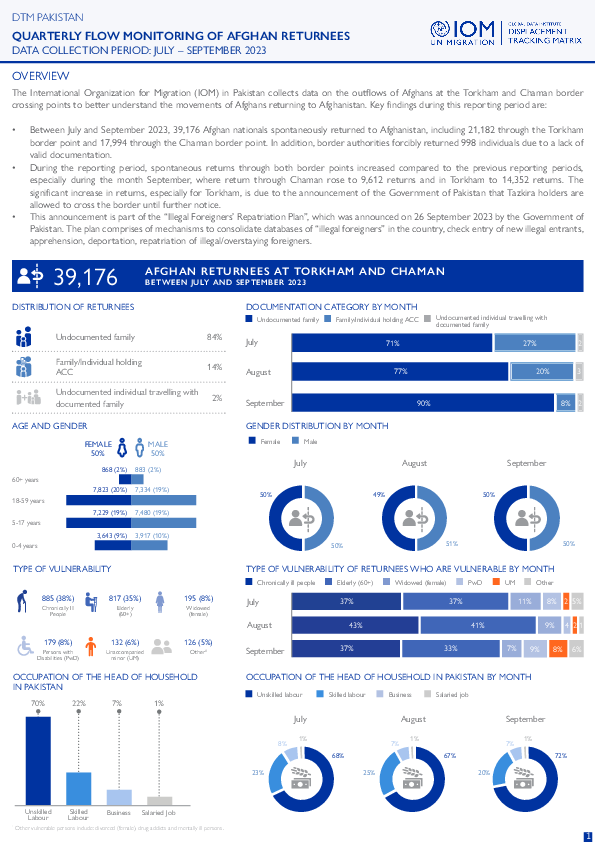
Contact
DTM Pakistan, iomisbdtmremapteam@iom.int
Language
English
Location
Pakistan
Period Covered
Jul 01 2023
Sep 30 2023
Activity
- Flow Monitoring
IOM in Pakistan collects data on the outflows of Afghans at the Torkham and Chaman border crossing points to better understand the movements of Afghans returning to Afghanistan. Key findings during this reporting period are:
• Between July and September 2023, 39,176 Afghan nationals spontaneously returned to Afghanistan, including 21,182 through the Torkham border point and 17,994 through the Chaman border point. In addition, border authorities forcibly returned 998 individuals due to a lack of valid documentation.
• During the reporting period, spontaneous returns through both border points increased compared to the previous reporting periods, especially during the month September, where return through Chaman rose to 9,612 returns and in Torkham to 14,352 returns. The significant increase in returns, especially for Torkham, is due to the announcement of the Government of Pakistan that Tazkira holders are allowed to cross the border until further notice.
• This announcement is part of the “Illegal Foreigners’ Repatriation Plan”, which was announced on 26 September 2023 by the Government of Pakistan. The plan comprises of mechanisms to consolidate databases of “illegal foreigners” in the country, check entry of new illegal entrants, apprehension, deportation, repatriation of illegal/overstaying foreigners.

Contact
DTM Chad, dtmtchad@iom.int
Language
English
Location
Chad
Period Covered
Sep 01 2023
Sep 30 2023
Activity
- Mobility Tracking
- Event Tracking
The purpose of the Emergency Tracking Tool (ETT) is to collect information on large and sudden population movements as well as on security and climate emergencies. Information is collected through key informant interviews or direct observation. This dashboard provides information on movements which occurred during the period from 01 to 30 September 2023, in the Lac Province.
During September 2023, several security incidents occurred in the Lac province and beyond (Niger), resulting in population displacements. A total of 3,546 households (12,627 individuals) were affected by displacement, which represents an increase of 43 per cent compared to August. Among the displaced population, 340 households (1,800 individuals) Chadian refugees who were forced to leave the sous-préfecture of N'guiguimi (Niger) for Daboua sous-préfecture. The vast majority (86%) of affected individuals during September were members of local communities before this displacement. The main reason for displacement was armed attacks (82%). The majority (65%) of displaced persons stayed in the same sous-préfectures (see table on page 2). The three essential needs reported by most displaced persons at their places of displacement were food (29%), non-food items (29%), shelter (23%) and water (19%).

Contact
DTM Nigeria, iomnigeriadtm@iom.int
Language
English
Location
Nigeria
Period Covered
Dec 12 2022
Jan 14 2023
Activity
- Survey
As of February 2023, 2,200,679 individuals were internally displaced in the BAY (Borno, Adamawa and Yobe) states of the north-east region, and 2.17 million individuals returned to their locations of origin. The unpredictability of the security crisis in BAY states has left for fluid mobility in these areas. This, coupled with the closure of major camps in Maiduguri Metropolitan Council (MMC), Jere and Konduga local government areas (LGAs) of Borno State. Many IDPs who resided in these camps have now integrated in host communities where they were displaced, some have reintegrated in their LGAs of origin and others have moved to different LGAs for resettlement.
To help find durable solutions for internal displacement — whether through return to communities of origin, local integration, or relocation – and to prevent new displacements in the region, it is critical to understand the relative levels of stability in locations hosting returnees or displaced populations. IOM launched the Stability Index (SI) in 2019 to evaluate the stability of areas hosting returnees or displaced populations in Nigeria. The SI seeks to understand factors influencing a location's stability to identify priority interventions for transition and recovery, with the goal of strengthening the resilience and stability in this conflict and displacement-affected region. The Stability Index measures perceptions of stability and analyzes factors having a larger impact on the decisions of populations to remain in place or move. The tool is implemented in the BAY states to enable governmental authorities and partners to develop better strategies, and to prioritize resources that link humanitarian, recovery, and stabilization approaches.
This report presents results from data collection of Stability Index Round 3 conducted in Nigeria’s BAY states (Borno, Adamawa and Yobe) between December 2022 and January 2023.
